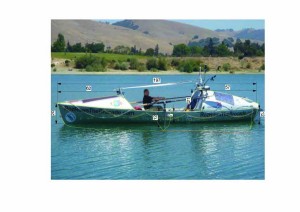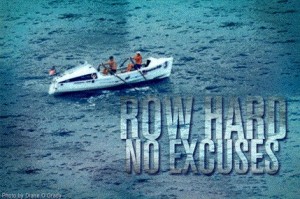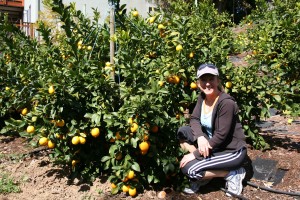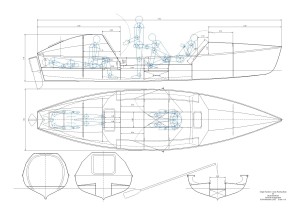
Does anybody have, or know where we can find, between 100 and 200lb (50 and 100kg) of lead shot? Preferably in the Bay Area, as weight-based postage costs could be prohibitive!
Today I was obsessed with weight - not mine, for a change. This was the weight of my boat. I took the Brocade and her trailer to a public scale in Hayward as part of my investigations into how much ballast I need to add to avoid last year's capsizing problems. This is a VERY high priority for me, as capsizing is really rather painful, and definitely not conducive to either a successful crossing or a good night's sleep...
At the end of the weighing exercise, these were the scores on the doors:
Total weight of car + boat + trailer = 8,400lb
Car = 6,020lb (yikes! but it does have most of my worldly goods in it too...)
Trailer = 625lb
So boat = 1,755lb (or 796kg)
This was with most but not all stuff on board. Still to come: Pelican cases of technology, some food, and assorted spares.
Also not included was water ballast, and I would expect to take 75 litres, i.e. 75kg of water.
Once these are added, the total weight will be about 921kg (2,030lb).
And there are the oars to take into account. These were probably a major factor in the capsize. They are heavy, and have to be stowed high on the boat because there is nowhere else for them to go.
I have two oars with lead cuffs, and two without. Weights are:
With cuffs: 13.6lb (6.2kg) x 2
Without cuffs: 10.6lb (4.8kg) x 2
Making a total of 22kg (48lb). This compares with the carbon fibre oars that I had last year, which were about 3.6lb each (1.6kg). So the new oars are THREE TIMES as heavy as the old ones - but all the old ones broke, and I'd rather have 4 heavy oars that don't break, than 4 light oars that do.
I have now sent all this information to the boat designer in the UK so he can finalize his calculations of the amount of ballast I need.
Problem is: we are struggling to find lead shot, which would be the ideal way to add ballast to the odd little spaces under the hatches. Apparently everybody uses cartridges these days rather than shot. We could use concrete, but this will be harder to weigh before putting it into the hull.
Hence my plea. Do please get in touch via the Contact form on this website if you have a solid suggestion as to where we can source some lead shot.
Thank you!
[photo: proposed changes to the skeg of the boat]
|
|

This coming Sunday, March 16, I will appearing at the Tiburon International Film Festival.
I will be taking part in a Q&A after the ocean rowing film Row Hard No Excuses, due to screen at 1.30pm at the Corinthian Yacht Club.
I don't appear in the film - it is about two American men who competed in the 2001 race - but I'm there as a token ocean rower to answer any questions from the audience.
Tickets can be purchased in advance by clicking here.
|
|

I like to shop local when I can, to save on food miles as well as ensuring I'm eating good fresh produce, so I was delighted when Karen Morss agreed to donate 50 lemons to the cause. Karen's sweet Meyer lemons are organically grown just a few miles from my current temporary home in Woodside. A half dozen have now been incorporated into some buckwheat crackers (lemon and asparagus flavour) that are drying out in my dehydrator as I write.
As well as lemons, I got a hefty dollop of inspiration when I went to meet her. Karen is a one-woman dynamo. At about five foot nothing, she makes up for lack of height with an abundance of energy. After running her own software company for 20 years, she decided to get her pilot's license. But she didn't think the flight school was up to scratch. So she bought it and improved it until it was good enough - acquiring a test pilot husband into the bargain.
She'd promised herself 5 years with the flight school, and true to her word, she sold it on the 5th anniversary of the purchase. Then she wrote a screenplay for a movie about the Wright Brothers (still to be made), which involved reading 2400 pages of handwritten letters written by their sister. And now she grows lemons. She rattled off her life story with a briskness that I suspect she brings to all her dealings. I imagine problems and obstacles get very short shrift.
This is her first year of lemon production, and already the yield from 40 tiny trees is exceeding all expectations - which pretty much sums up Karen's life.
I asked Karen what her one top tip for success in business would be. This is what she said:
My father said it best when he told me he would rather see me sell apples on a streetcorner than become the VP of General Motors. That way I would always make my own destiny. I am a big believer in making destinies! If you can dream it, you can believe it. If you can believe it, you can do it.
Photo: Each of the trees is named after a woman who has inspired Karen at some stage of her life, and I was immensely flattered when she asked if she could name a tree in my honour. So after Roz the Albatross, we now have Rosalind the Lemon Tree. The photo shows me with my namesake. I'm the one on the right.
|
|

Last summer my boat was nearly rescued by Steve Fossett's yacht, the Cheyenne. Now the Cheyenne's crew may be coming to my rescue in a rather different way...
Last year's Pacific bid ended prematurely due to large waves and the loss of my sea anchor causing my boat to capsize. It seemed to me at the time that the waves were no larger than anything that I had encountered on the Atlantic, so it seemed likely that the cause of my problems was all the extra bits and pieces that had accumulated on the roof of my cabins - aerials, antennae, weather stations, and a considerably heavier pair of spare oars. (After all 4 of my oars broke on the Atlantic, I had opted for solid ash oars rather than hollow tubes of carbon fibre.) None of these items were a major weight in themselves, but the cumulative total was apparently enough to shift the centre of gravity upwards - leading to capsize.
So I've been talking with Nancy from the Cheyenne, a dab hand in glass fibre work, who is on standby to do the work as soon as we have finalized the specification.
And I've been on the phone to Devon in England talking to Phil Morrison, the original designer of the hull, to ask his advice on how much weight might be needed, and where it should be distributed. It has been invaluable finding out more about the why and the wherefore of the hull design. For example, I learned that the intention is that when a big wave broadsides the boat, rather than the hull 'digging in' to the water and the boat tipping over, the hull is designed to skid sideways across the water, while the boat remains upright - provided, of course, that the centre of gravity is in the right place.
At first I thought we were going to have to add a kind of false bottom to the boat - laying a lead pipe (or similar) along the central ridge that runs the length of the hull, and then glassing it in. But then it occurred to me that several of the hatches along the centre line have flat bottoms, so there is presumably an empty air space between the hatch floors and the hull - so now we are exploring the possibility of creating access to these areas via the hatches and inserting ballast from above. This would be much simpler - and hence cheaper.
I have just 3 months now before I go on standby to depart. Rick Shema, my weather guy, tells me that this is an El Nina year. Although the effects of La Nina will be diminishing by summer, it could still cause higher-than-average winds, and hence waves. So if I am to avoid a repeat of last year's washing machine simulation, a rebalancing of the boat is top priority.
|
|